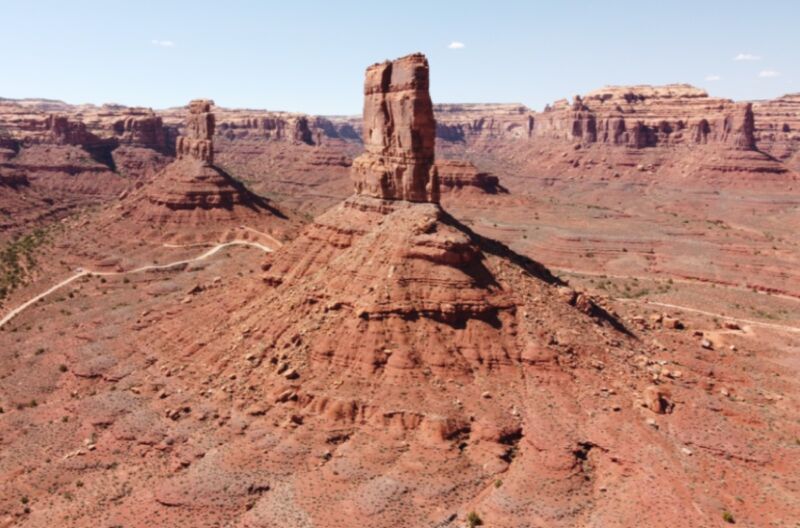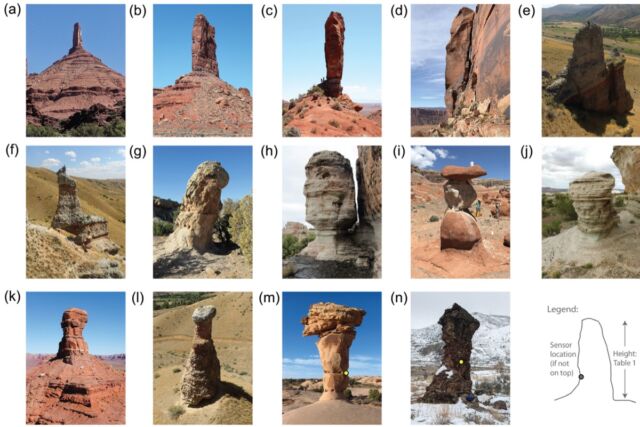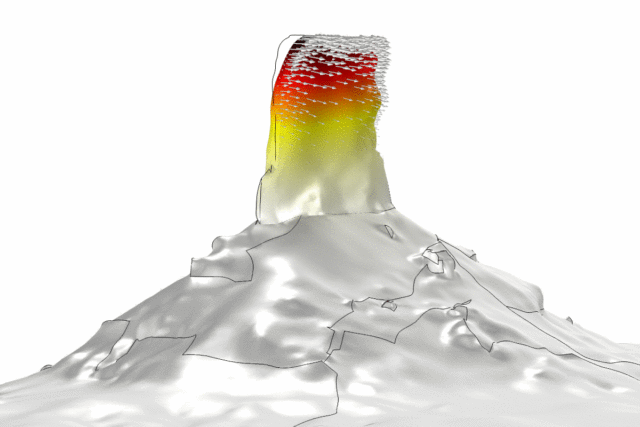
Geohazards research group
The distinctive red rock towers and arch formations found throughout Southern Utah and the Colorado Plateau are known to shake and sway in response to earthquakes, high winds, thermal stresses, and other sources of vibration, such as those from helicopters, trains, passing vehicles, and explosions. It can be challenging to assess the stability of these structures and detect any damage from vibration. That is why geologists have been measuring the natural frequencies of these towers for several years now.
Led by geologist Jeff Moore of the University of Utah, the group of geologists maintains an entire webpage devoted to the seismic records of the natural resonances (vibrations) emanating from Utah’s red rock towers and arches. The geologists have now used that dataset to develop a theory that can predict the frequencies at which these formations vibrate and deform, described in a recent paper published in the journal Seismological Research Letters.
Overcoming obstacles
As we reported before, understanding those dynamics is crucial to predicting how the structures will react in the event of an earthquake or similar disturbance. Yet, not many attempts have been made to do this over the years, despite much research into man-made civil structures. One of the biggest challenges was getting the access needed to do those vibration measurements in the first place. Either the formations are limited (the better to save them for posterity), or it’s just too difficult to place sensors in hard-to-reach places on the formations.
So Moore and his collaborators relied on a team of experienced mountaineers, including experienced climber Kathryn Vollinger, to climb the structures, place seismometers on the summit, and then wait quietly for several hours while those instruments collected data. Co-author Riley Finnegan, a graduate student at the University of Utah, and several other team members visited three of the sites Vollinger had climbed and used drones to map the structures for 3D models. “Personally, I could barely get to the base of one of the towers, let alone start thinking about carrying our gear to the base and then climbing up with everything in tow,” she said.

R. Finnegan et al., 2022
In 2019, Moore, Finnegan and the rest of their team took the first detailed seismic measurements of a pillar-shaped sandstone formation in Utah known as Castleton Tower. They found that the structure vibrates at two main resonant frequencies: 0.8 and 1.0 Hz, respectively. That makes the formation vulnerable to strong earthquakes, which fortunately are quite rare in the region. Smaller earthquakes — or minor vibrations from traffic, construction machinery, or other environmental factors — are unlikely to trigger the tower’s natural resonances.
This time, the team worked with a highly comprehensive data set, including rock towers of varying heights and geometries. The researchers measured the environmental vibrations of 14 rock towers (defined as slender in both horizontal dimensions) and fins (defined as symmetrically tall in one direction) in Utah, located on traditional land of the Eastern Shoshone, Hopi, Navajo, Southern Paiute, Ute and Zuni tribes. (A student from Whitehorse High School in Montezuma Creek near Valley of the Gods, Weston Manygoat, helped them with their fieldwork.)
With the help of their intrepid mountaineers, the geologists were able to place seismometers directly on top of all but two of these sites: Red Narrows and Secret Spire. They were also able to extract other data on the natural frequencies and geometries of rock towers, pillars and pinnacles from previous studies and reports, including formations in Arizona, the Negev desert of Israel and the Vercors massif in France, as well as formations in Utah. The researchers then collected all the data collected over several years into one large dataset for analysis.

Geohazards research group
Encouraging results
The results: The fundamental frequencies of the rock towers fall between 1 Hz and 15 Hz. Larger towers have lower fundamental frequencies and sway back and forth while vibrating in most cases. However, some towers with higher fundamental frequencies revolve around the central axis.
The researchers had theorized that the fundamental frequency at which a beam vibrates would be proportional to its width divided by its height squared. This turned out to be largely the case. Thus, it should be possible to accurately estimate the fundamental frequency of a given formation based on measurements of its geometry alone, in addition to its material properties. (Most of the structures in the study were composed primarily of sandstone.) Their model’s frequency predictions differed only 4 percent from the data, while the towers’ predicted angle of motion differed about 14 degrees.
“Maybe I’m overly excited and surprised about this, but I’ve made enough models of rock arches in one of our other work that frustratingly didn’t produce strong matches with the data, so it was refreshing for me to be able to predict tower models given the geometry Finnegan said. She added:
This ability to make predictions about a tower’s fundamental frequency using just the tower’s width, height and material properties is powerful because it means that one doesn’t necessarily have to climb a 100-meter tower with a seismometer to get this information. to get . And knowing this information is important for all assessments related to a tower’s seismic stability or possible vibration damage.
DOI: Seismological Survey Letters, 2022. 10.1785/0220210325 (About DOIs).

